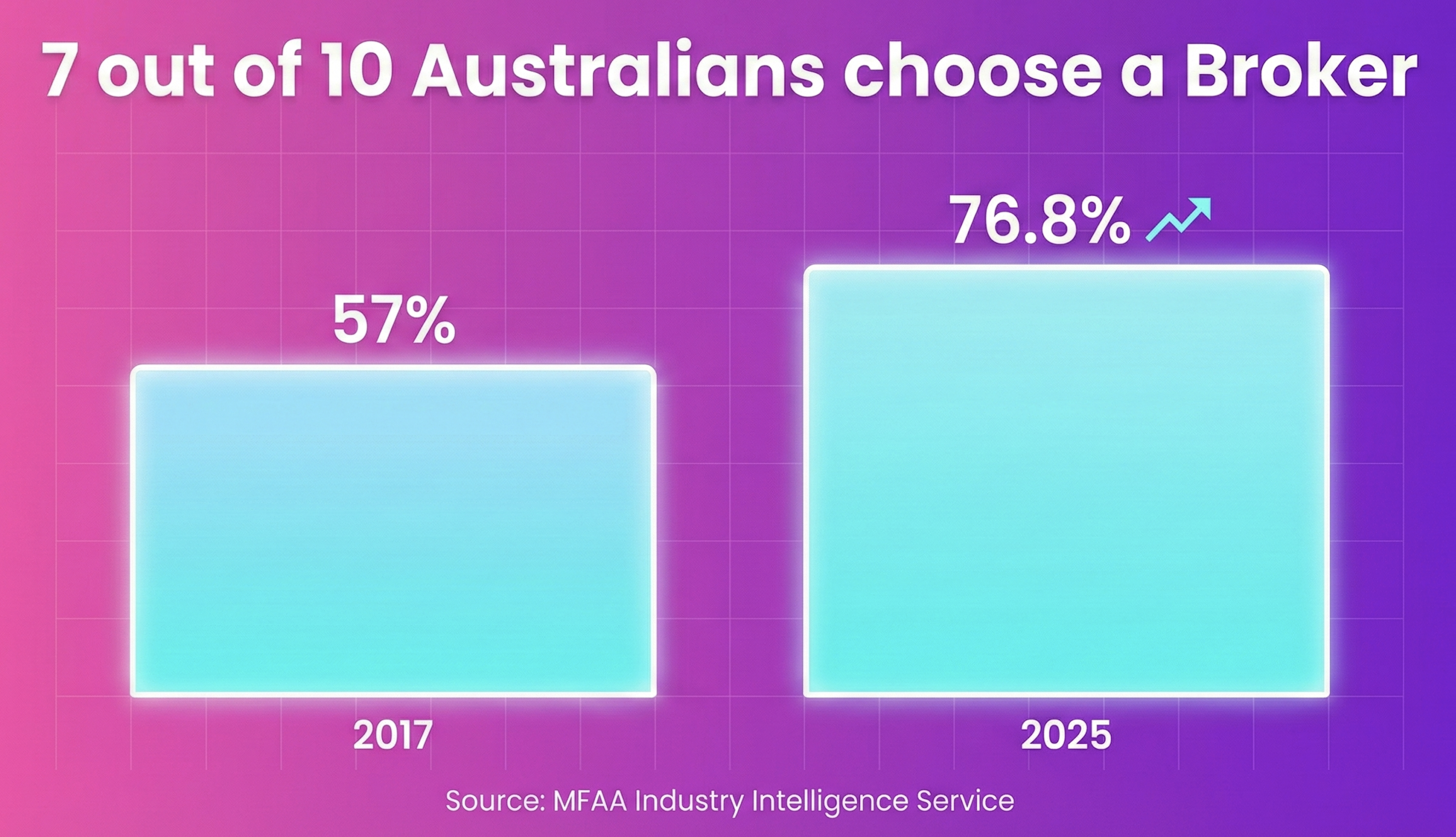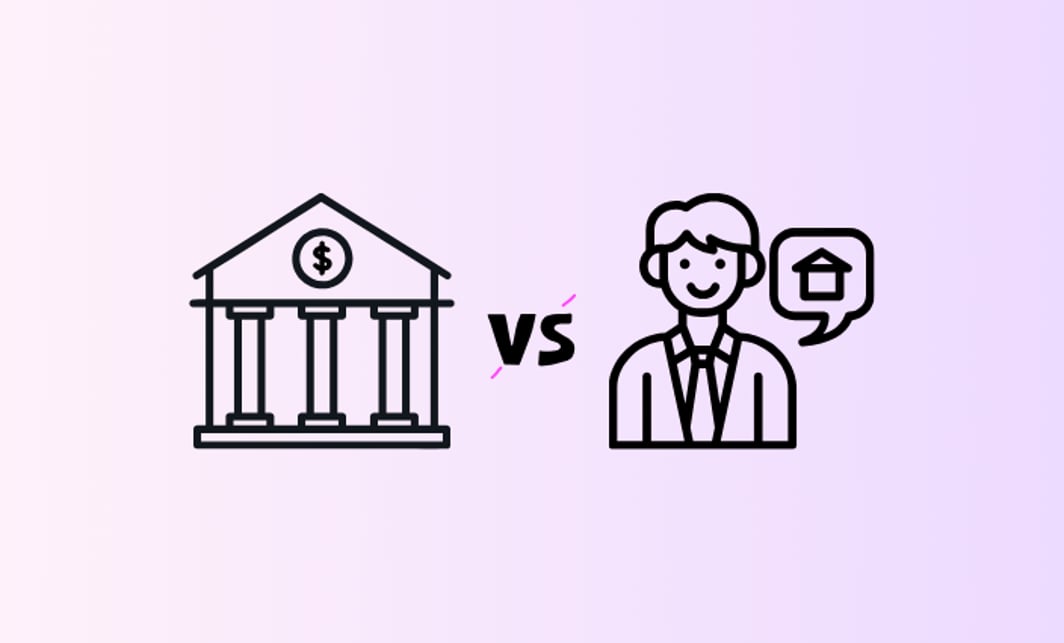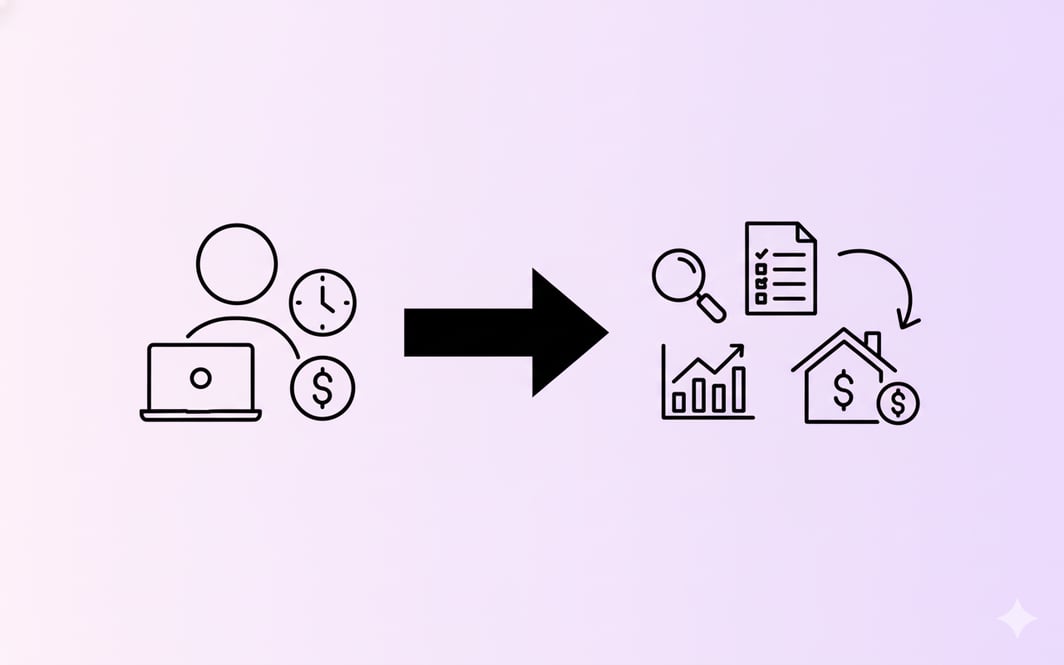Quick Verdict: Broker or Bank?
For most Australians, a mortgage broker is the better choice if you want access to 30+ lenders, need help with complex income (like self-employment), or want a professional to negotiate rates on your behalf. Go directly to a bank if you have a simple financial situation, a large deposit, and want to stick with your current institution for convenience.
If you’re looking for a home loan in Australia, you’ll need to decide whether to work with a mortgage broker or go straight to a bank. This guide explains the main benefits and drawbacks of each option. The right choice depends on your situation, goals, and the kind of support you want during the process.
Pros and Cons of using a mortgage broker
Pros:
- Access to a wide range of lenders and home loan products
- Expert guidance tailored to your financial situation
- Can save you time by handling comparisons and paperwork
- May negotiate better rates or terms on your behalf
- Brokers are typically free to borrowers (paid by the lender).
Cons:
- Brokers don’t have access to every lender or loan on the market.
- Recommendations may be limited to their panel of lenders.
- Potential for bias due to commission-based compensation
Pros and Cons of going directly to a bank
Pros:
- Direct access to the lender’s full range of products and specials
- May leverage an existing banking relationship for discounts or faster approvals
- No intermediary, greater transparency in the loan process
Cons:
- Limited to the bank’s own loan options
- You must do all research, comparisons, and negotiations yourself.
- May miss out on competitive offers from other lenders
What are the key takeaways for borrowers comparing mortgage brokers and banks?
Scenario 1: The "First-Time" Navigator
Target Audience: Users searching for "help buying first home Australia"
Scenario 2: The "Complex Income" Earner
Target Audience: Users searching for "home loan for contractors" or "self-employed mortgage"
Scenario 3: The "Loyal" Refinancer
Target Audience: Users searching for "fastest home loan approval"
What should you know about mortgage brokers and banks in Australia?
What is the current state of the Australian home loan market?
The Australian home loan market continues to see mortgage brokers dominate, accounting for about 76.8% of all new residential home loans in the March 2025 quarter—up from roughly 74.1% a year earlier and significantly higher than 57% in 2017. This reflects the ongoing, growing influence of brokers in connecting borrowers with a wide range of lenders, including both banks and non-bank financial institutions. Understanding the strengths of mortgage brokers is key if you’re comparing home loans in Australia.

Brokers are handling increasing volumes: in the March 2025 quarter alone, brokers settled AU$99.37 billion in new home loans, a nearly 22% increase year-on-year. While banks remain the main sources of funds, an increasing number of loans are being accessed via brokers. The “big four” banks (Commonwealth Bank, NAB, ANZ, Westpac) still hold a large share of the home lending market directly, accounting for approximately 70–75% of outstanding loan value. However, small and medium banks, as well as non-bank lenders, are now relying heavily on the broker channel for new originations. Individual bank disclosures (for example, Macquarie) indicate that a very high proportion, often 90–95%, of new loans from these lenders are broker-originated, even if exact splits for all medium banks aren’t always published.
What are the roles of mortgage brokers and banks?
- Mortgage brokers in Australia are licensed credit intermediaries who help Calculate your borrowing power and assess your financial situation, then source and recommend suitable home loan products from multiple lenders. A home loan broker can provide advice, manage paperwork, and often assist with loan applications and refinancing processes. They receive commissions from lenders but are legally required to act in the best interests of borrowers under regulations set by the Australian Securities and Investments Commission (ASIC). You can verify a mortgage broker’s credentials through ASIC’s professional registers or by contacting industry associations such as the Mortgage & Finance Association of Australia (MFAA) or the Finance Brokers Association of Australia Limited (FBAA).
- Banks are financial institutions that provide home loans directly to customers. Borrowers applying directly with banks engage with the bank’s own lending products and processes. Banks manage loan approval, servicing, and customer relationships internally, typically offering fewer product options compared to brokers’ lender panels. Browse all products from various banks at one place.
The "Safety Net" Law: Why brokers are safer?
Since January 1, 2021, a federal law known as the Best Interests Duty (BID) applies only to Mortgage Brokers, not Banks.
- Mortgage Brokers: Must legally prioritise your financial interests above their own commissions. If a lender pays a higher commission but offers a worse rate, the broker cannot recommend it.
- Banks: Are not bound by this duty. They can (and do) sell you their own products even if a competitor offers a better deal.
The Verdict: When you use a broker, you have a legal safety net that bank customers do not.
How do interest rates, fees, and costs compare between brokers and banks?
Interest rates are a primary concern for borrowers comparing home loans in Australia. Data suggests interest rates on loans arranged through mortgage brokers and those applied for directly at banks are lender-dependent rather than channel-dependent. Mortgage brokers can provide competitive rates because they have access to multiple lenders and sometimes negotiate better offers or find niche loan products.
However, mortgage pricing in Australia suffers from a lack of transparency, complicating direct comparisons. Banks often employ discretionary pricing mechanisms that are not always transparent to borrowers, which can obscure the true competitiveness of their rates compared to those of broker-arranged loans.
Reserve Bank data indicate that average new owner-occupier loan rates were around 5.83% per annum in early 2025, with some recent declines following cash rate cuts. Brokers often help borrowers access these competitive rates, and their market share growth suggests borrowers trust brokers to deliver favourable pricing.
In summary, brokers generally offer competitive interest rates relative to direct bank applications, but the advantage varies depending on the lender and market conditions.
How do fees and commissions affect borrowers when choosing between brokers and banks?
Mortgage brokers typically earn commissions from lenders, including upfront and trailing commissions, which are paid by the lender and not directly by the borrower. These commissions usually range from 0.05% to 0.15% annually on the loan balance. Despite this, loans arranged through a mortgage broker in Australia have been found to offer, on average, a 0.25% larger discount compared to direct bank loans, potentially offsetting the costs of commissions.
Banks generally charge fees, including application, establishment, and ongoing account-keeping fees. Competition has driven many banks to reduce these fees or offer cashback incentives, especially to attract refinancing customers.
Regulatory reforms implemented after 2017 have increased brokers' compliance costs and transparency obligations, which may impact fee structures and borrower costs.
Is refinancing more cost-effective with a broker or a bank?
Refinancing is a crucial consideration for existing homeowners seeking more favorable rates or loan terms. Brokers excel in this area by accessing a broader range of lenders, including non-bank lenders funded through securitisation. This wider access often results in more competitive refinancing options than those offered directly by banks.
While banks have responded to recent cash rate increases by offering competitive retention rates, the overall competition for refinancing has softened, giving brokers an edge in finding better offers for borrowers.
Brokers' commissions are generally outweighed by the savings borrowers achieve through better rates secured via their services, making broker-assisted refinancing cost-effective for many Australians.
What are the benefits and key considerations for borrowers?
What are the advantages for first home buyers using mortgage brokers?
First home buyers benefit significantly from using mortgage brokers in Australia. Brokers provide access to a wide range of lenders, increasing the likelihood of securing competitive interest rates and loan features tailored to their individual financial situation. In fact, first home buyers using mortgage brokers have been able to check potential repayment savings by securing interest rate reductions averaging 0.35% compared to direct bank applications..
Mortgage brokers are also required to act in the best interests of their clients, as mandated by ASIC’s regulations. This “best interests duty” ensures that brokers recommend options that are most suitable for your needs, not simply those that offer them the highest commission. In addition to providing personalised advice and education about the home loan process, they spend approximately 11% of their time educating customers, which is invaluable for first-time home buyers new to the market.
Brokers arrange approximately 75% of new Australian residential loans, with 45% of their owner-occupier clients being first-home buyers, indicating their specialisation in this segment.
How do fees and affordability compare for first home buyers working with brokers vs banks?
Mortgage brokers may charge brokerage fees, but these are increasingly transparent and often tax-deductible. Banks typically do not charge broker fees but may levy application and ongoing fees.
Despite potential broker fees, brokers have been shown to save borrowers an average of $2,976 annually by securing better interest rates and loan terms. Given the rising mortgage costs—the average loan size for owner-occupiers reached $624,000, with interest rate increases of 125 basis points in 2023—these savings significantly improve affordability.
Do mortgage brokers give better access to competitive refinancing options?
Mortgage brokers' access to non-bank lenders and a wide range of lender options gives borrowers more refinancing choices, including options not available directly from banks. Non-bank lenders often have alternative funding structures, such as securitisation, allowing brokers to present competitive, tailored refinancing options.
This broader access is crucial in a market where banks may prioritise existing customers and limit new refinancing offers. Brokers play a vital role in helping homeowners reduce mortgage stress by offering better refinancing deals.
How do digital platforms shape the customer experience for mortgage brokers and banks?
What is the quality and impact of online mortgage broker platforms?
Online mortgage broker platforms have become critical tools for borrowers. Reviews indicate that brokers have leveraged digital channels effectively, contributing to their rising market share of 71.7% in late 2022 and to 76.8% as of the MFAA.
These platforms often feature user-friendly interfaces, competitive loan offers with cashback incentives, and tools for comparing loan products, enhancing borrower convenience and transparency. However, regulatory scrutiny underscores the need for secure, compliant digital environments, which is reflected in consumer trust and satisfaction.
How do processing times and approval rates compare between brokers and banks?
Processing times and approval rates vary between brokers and banks. Brokers help reduce borrower confusion around mortgage products, aiding smoother applications. However, broker platforms sometimes face challenges with communication, technology reliability, and processing speed.
Banks benefit from regulated, secure digital portals and the introduction of government-backed digital identity frameworks, which enhance application efficiency and the reliability of approval.
Recent surveys indicate that borrower satisfaction with brokers' application processes has declined, underscoring the need for brokers to enhance their digital infrastructure and communication.
Overall, banks may have an edge in processing speed and certainty of approval, but brokers offer valuable advisory support and access to a wider range of lenders.
How do market share and lending patterns differ between brokers and banks?
Mortgage brokers' market share has steadily increased, now facilitating about 75% of new home loans, especially for small and medium-sized banks.
This shift enhances competition, lowers borrowing costs, and expands lender options for consumers.
What legal obligations and consumer protections exist for mortgage brokers and banks?
What disclosure requirements apply to mortgage brokers?
Mortgage brokers in Australia are required to comply with ASIC's Regulatory Guide 273, which mandates acting in the best interests of consumers and fully disclosing all fees, commissions, and any potential conflicts of interest.
Since 2021, brokers cannot rely solely on consumer consent to disclosures; they must ensure transparency and clear communication about the remuneration they receive from lenders.
Most brokers do not charge direct fees to consumers; instead, they earn commissions from lenders. However, disclosure of these commissions is compulsory to maintain consumer trust and ensure regulatory compliance.
What regulatory protections and dispute resolution options are available to borrowers?
Consumers who believe brokers or banks have breached their obligations can seek recourse through the Australian Financial Complaints Authority (AFCA), which handles disputes related to fee disclosure and breaches of the best interests duty.
ASIC enforces compliance through investigations and penalties, exemplified by significant fines imposed on firms for misleading conduct and inadequate fee disclosure.
Consumer protections are further supported by the National Credit Act and Australian Consumer Law, providing avenues for legal remedies in cases of mis-selling or unconscionable conduct.
These protections ensure that consumers can confidently navigate the mortgage market, with mechanisms in place to address grievances.
In summary, choose a Mortgage Broker if you are a first home buyer, self-employed, or want to compare rates from multiple lenders to save money. Choose a Bank directly if you have a large deposit, simple income, and prefer the convenience of keeping all your finances in one place.
Frequently asked questions
Yes, using a mortgage broker in Australia is highly safe and regulated.
In fact, since January 1, 2021, it is arguably "safer" than going directly to a bank due to a federal law called the Best Interests Duty (BID).
Here is why you are protected:
- The "Best Interests Duty" (BID): Unlike bank employees, mortgage brokers are legally required to act in your best interests. They cannot recommend a loan just because it pays them a higher commission. If a cheaper or better loan exists for your situation, they must offer it. Bank staff do not have this legal obligation; they act in the best interests of their employer (the bank).
- ASIC Regulation: All reputable brokers must hold (or be authorized under) an Australian Credit Licence (ACL) issued by ASIC. This ensures they are qualified, trained, and insured.
- Dispute Resolution: Brokers must belong to an external dispute resolution scheme (like AFCA). If something goes wrong, you have an independent body to turn to for free.
💡 Pro Tip: Always ask your broker for their Credit Guide before you start. This document confirms their license number and outlines how they are paid, ensuring 100% transparency.




